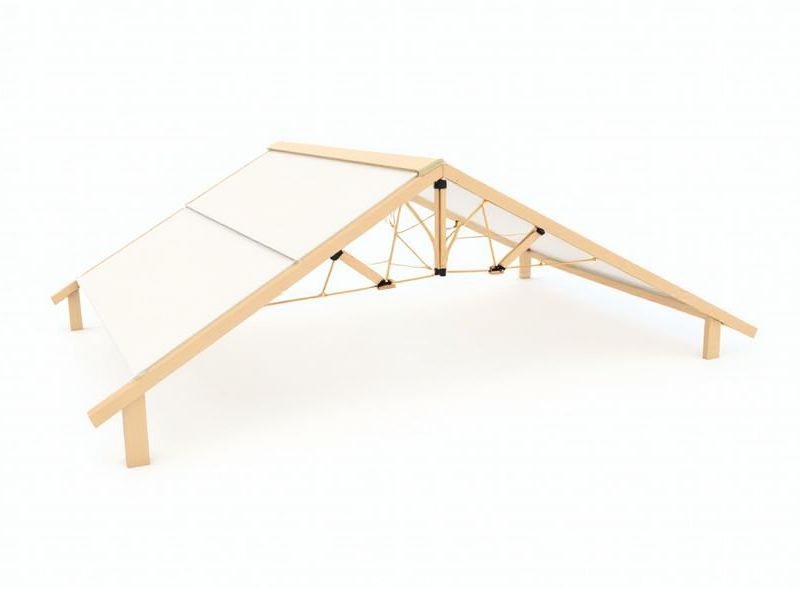
When determining the standard dimensions of a roof truss, it's important to consider factors like span, pitch, and intended load, as these can vary widely based on regional building codes and project requirements. For residential construction, common roof truss spans range from 6 to 14 meters (20 to 46 feet), with a standard truss depth (or height) of about one-fifth to one-sixth of the span. For example, a truss spanning 10 meters would typically be 2 to 2.5 meters deep (6.5 to 8 feet). Always check with local guidelines or a structural engineer to ensure that your chosen truss dimensions will safely meet your specific roofing needs.
Span Length
Roof trusses typically have a standard span length that ranges from 20 to 60 feet, depending on the design and intended use. The exact span length affects load distribution, structural integrity, and overall building cost. For residential constructions, a common span is around 24 feet, allowing for effective support for various roofing materials. Properly designed trusses can accommodate heavier loads while remaining lightweight, crucial for energy efficiency and minimizing material costs.
Pitch/Slope
A roof truss's pitch, typically measured in ratios like 4:12 or 6:12, indicates the angle of the roof, impacting both aesthetics and water drainage efficiency. A steeper pitch, often exceeding 6:12, can enhance snow shedding and increase attic space, while a lower pitch may be more suitable for areas with minimal snowfall. In residential construction, maintaining a pitch between 3:12 and 12:12 is generally recommended for optimal structural performance and compliance with building codes. Understanding these parameters is crucial for ensuring your roof truss design meets both functional and aesthetic standards.
Overhang
The standard overhang for roof trusses typically ranges between 12 to 24 inches, depending on the design requirements and local building codes. An adequate overhang helps in protecting the exterior walls from rainwater, thereby enhancing the durability of your structure. Furthermore, proper overhangs contribute to energy efficiency by reducing heat gain during summer months, making your building more comfortable. It is essential to consider both aesthetic and functional aspects when designing the overhang to maximize performance and curb appeal.
Rise
The standard rise for roof trusses typically ranges from 4:12 to 12:12, representing a slope that is between 18.4 degrees and 45 degrees. This rise affects not only the aesthetics of the building but also its structural efficiency and the effectiveness of water drainage. A greater rise can provide increased attic space and better ventilation, which may enhance energy efficiency by allowing for improved airflow. When designing your roof truss system, it's crucial to consider regional building codes that may dictate specific rise ratios based on local climate conditions and architectural styles.
Web Configuration
Web configuration in roof trusses plays a crucial role in ensuring structural integrity and load distribution. Common configurations include the Warren, Pratt, and Howe designs, each with unique advantages and load-bearing capabilities. For example, the Warren truss, featuring equilateral triangles, excels in distributing loads evenly across its span, while the Pratt truss effectively supports vertical loads through its diagonal web members. Understanding these configurations can help you choose the most efficient design for your building project, ultimately enhancing safety and longevity.
Bottom Chord
The bottom chord of a roof truss typically serves as a vital structural component, with dimensions commonly ranging from 2x4 inches to 2x10 inches. This element is crucial in distributing the load evenly across the truss, often handling forces that average between 10 to 15 pounds per square foot. For optimal performance, the span of the bottom chord can vary, generally between 20 to 60 feet based on the design and intended roof pitch. When selecting materials, engineers frequently recommend using high-strength steel or engineered wood, ensuring that your truss system meets the required building codes and safety standards.
Top Chord
The top chord of a roof truss is critical for providing structural integrity, typically composed of materials such as wood, steel, or engineered wood. Standard specifications often require that the top chord can support loads exceeding 50 pounds per square foot (psf), accommodating both dead and live loads. In residential construction, common spans range from 20 to 60 feet, necessitating precise calculations to ensure safety and stability. Proper bracing and connection methods further enhance the top chord's performance, ensuring it maintains the truss's intended geometry under various environmental conditions.
Truss Depth
The depth of a roof truss significantly influences its structural efficiency and load-bearing capacity, with standard depths typically ranging from 12 to 24 inches. A deeper truss allows for greater spanning capability, enhancing the structure's ability to support heavier loads such as snow accumulation or roofing materials. Designers often calculate the optimal truss depth based on factors such as building height, expected wind loads, and local building codes. By carefully selecting the truss depth, you can ensure your roof system is both cost-effective and structurally sound.
Spacing Between Trusses
The standard spacing between roof trusses typically ranges from 24 inches to 48 inches apart, depending on the roof's design and load requirements. For residential structures, a common practice involves spacing trusses at 24 inches, allowing for adequate support and insulation placement. Alternatively, commercial buildings may utilize 48-inch spacing, optimizing material efficiency while ensuring structural integrity. Always consult local building codes and engineering guidelines to ensure your truss spacing meets safety and performance standards.
Load-Bearing Capacity
The load-bearing capacity of roof trusses is a critical factor in ensuring structural integrity, particularly in residential and commercial buildings. Typically, a well-designed truss can support loads ranging from 20 to 60 pounds per square foot, depending on material strength and span length. Engineered wood, steel, and aluminum are common materials that enhance durability and load distribution. Proper calculations, including live and dead loads, should be performed to optimize your design and ensure safety and stability under varying conditions.
